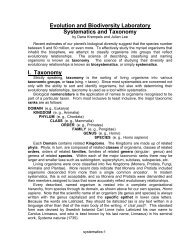Study Guide for Exam I
Study Guide for Exam I
Study Guide for Exam I
Create successful ePaper yourself
Turn your PDF publications into a flip-book with our unique Google optimized e-Paper software.
Understand the molecular basis of sister chromatid similiarity (i.e., DNA replication producing<br />
two identical copies)<br />
NOTE: We will be returning to the concept of the difference of alleles at the molecular<br />
level in our section on molecular genetics. So you don’t’ need to focus very specifically<br />
on pages 44-49—at least <strong>for</strong> the moment.<br />
Know the difference between autosomes and sex chromosomes. Know the various ways by<br />
which sex can be determined in different species.<br />
Know the meaning/significance of: X chromosome, Y chromosome, isogametic species,<br />
heterogametic species, homogametic sex, heterogametic sex, sex linkage, X linkage, Y linkage,<br />
pseudoautosomal and differential regions of X and Y chromosomes, hemizygosity, aneuploidy,<br />
Turner Syndrome, Klinefelter Syndrome<br />
Be able to calculate expected progeny in both autosomal and sex-linked inheritance.<br />
Understand the basics of pedigree analysis, and be able to read a pedigree and determie the<br />
most likely type of inheritance. What is a propositus? A proposita?<br />
Know the meaning/significance of: consanguinous mating, inbreeding, outbreeding,<br />
Understand how mosaic expression effects dosage compensation in female mammals.<br />
Know the contributions of Mary Lyon, Mary Barr, Ewart Bertram.<br />
Know the meaning/significance of: Barr Body, heterochromatin, euchromatin, sex-influenced<br />
traits, sex-limited traits, primary/secondary/tertiary sex ratios, sexual dimorphism, cohort,<br />
hybrid vigor, heterozygote advantage (read about this on pages 93-94 of your text.)<br />
Know how to calculate the expected ratios of offspring in just about any type of cross I might<br />
throw at you.<br />
Statistics in Genetics<br />
Know the meaning/significance of: attribute/qualitative data, discrete numerical data,<br />
continuous numerical data, mean, mode, median, range, standard deviation, variance, statistic<br />
vs. parameter, Probability calculations vs. Statistical tests<br />
Know how and when to apply the Sum Rule, Product Rule, and Binomial Theorem to calculate<br />
combined probabilities of independent and non-independent events. (NOTE: This is VERY<br />
clearly spelled out in the lecture notes, and you should NOT have to ask about this!)<br />
Know how and when to apply a Chi Square test. Know how to calculate the degrees of<br />
freedom, and look up the Chi square statistic, if given a table of critical values.<br />
NOTE: You need not memorize equations. Just be able to recognize them. I will provide all<br />
equations on the last page of the exam.<br />
Know the meaning/significance of: Type I Error, Type II Error<br />
Non-Mendelian Inheritance<br />
Understand the meaning/significance of: polygenic inheritance as it relates to continuous traits<br />
Know the basic mode of inheritance <strong>for</strong> mitochondrial and chloroplast genes. Understand the<br />
phenomenon of maternal inheritance, and the genetic drift behind Cytoplasmic Segregation and<br />
Reassortment (CSAR). (What is a cytohet/heteroplasmon?)<br />
Know the meaning/significance of: mitochondrial cytopathy, plasmid inheritance (remember<br />
the kal plasmid!), epigenetic inheritance, paramutation, parental imprinting. (We will return to<br />
these ideas later in the semester, but <strong>for</strong> now you should at least know what they mean.)<br />
Mapping Chromosomes<br />
Remember: If you are not already familiar with the details of mitosis and meiosis, use the Cell<br />
Division Primer (http://www.bio.miami.edu/dana/dox/cell_division.html) to review.<br />
Understand the details of independent assortment in both linked and unlinked gene loci. Know<br />
the meaning/significance of: linked loci, linkage group, parental vs. recombinant gamete<br />
configurations, test cross, map function. (We did mapping only <strong>for</strong> diploid organisms, though it<br />
also can be done <strong>for</strong> haploid organisms much more easily. For this exam, concentrate on the<br />
diploid mapping we did. Know only that <strong>for</strong> haploid crosses you don’t have to worry about

















